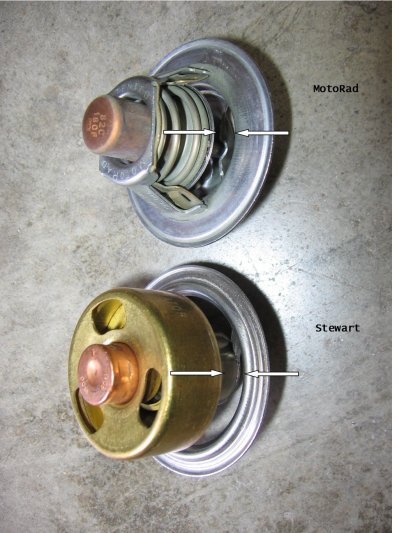Realized I ordered the wrong water pump for use with my 78 corvette thinking any 'short' pump would work. After some research, now I know what I need. Going for a high volume pump with a 3/4 pilot and 5.8" block to hub face measurement.
Info I found on one of the corvette forums...
Corvette – Water Pumps
The "Corvette short" water pump which you refer to applies only to small blocks and not big blocks. ALL 65-74 Corvette big blocks use the same, BASIC water pump casting (although 4 different castings were used). All 65-70 big blocks use a bearing/shaft assembly with a 3/4" diameter shaft, but a PILOT (the end of the shaft which centers the pulleys and fan clutch) turned down to 5/8". 1971-74 big blocks use a full 3/4" pilot.
For Corvette small blocks, ALL 55-70 Corvettes use a "short" water pump with a 5/8" shaft. This same style water pump was also used on all 55-68 small blocks used in all other Chevrolet passenger cars with small blocks. In 1969, most Chevrolet small blocks and big blocks, EXCEPT CORVETTE, went to the "long" water pump which still used a 5/8" shaft. Block to hub face is 5-5/8 (5.625)
In 1971, virtually ALL of the small block water pumps changed. All, EXCEPT the CORVETTE, continued to be "long leg" style but with 3/4" shaft and 5/8" pilot. Corvette continued to use a "short leg" water pump, but it was a DIFFERENT short leg water pump than used for 55-70 Corvettes. This water pump, often referred to as the "Corvette short" water pump, was set up to accommodate the large bearing and shaft assembly which used a 3/4" shaft. For 71-82 Corvette pumps, the shaft PILOT was the full 3/4". The full 3/4" pilot small block water pumps are unique to Corvettes and some medium/heavy duty trucks which also used the "Corvette short" water pump. I might also add that 71-74 Corvette big blocks ALSO used the 3/4" pilot shaft and they were the only big block water pumps which did so.
Due to its design, the "Corvette short" water pump has a slightly greater block mounting surface-to-face of hub flange dimension. Block to hub face is 5-13/16 (5.900). Combined with the fact that the 71+ pump has the full 3/4" pilot, it is applicable to only 71+ model Corvettes (and the trucks mentioned). The "Corvette short" water pump is NOT applicable to 55-70 Corvettes unless the entire pulley system, fan clutch and fan are changed to the 71+ configuration.
I might also add here, for clarification, by water pump SHAFT diameter, I am talking about the portion of the shaft that goes THROUGH THE BEARING. All Corvette water pumps use a 5/8" impeller shaft end. For 65-70 small block Corvettes, this means that the shaft is 5/8" all the way from end-to-end. For 71+ Corvette small blocks, the impeller end of the shaft is turned down to 5/8".
There were several GM castings used for the 55-70 Corvette and 55-68 ALL small block "short" water pumps. However, for the 71-82 "Corvette short" water pump, there were only 2 castings ever used. 1971-early 1972 used GM #3991399. Later 1972 to 1982 used GM #330813. These are the only 2 castings which GM EVER used for the "Corvette short" water pump. The 3991399 has no drilled and tapped boss on the top for external bypass. The 330813 does have a large upper boss and 3/4" NPT fitting for external bypass. The external bypass provision was plugged with a square head pipe plug for all 72-82 Corvette applications. The fact that this boss and tapping was added to the pump was only for the truck applications that also used it.
Chevy Water Pump Specifications Summary:
Short-Style Pump for most 1955-72 cars & trucks (5/8" pilot shaft)
• Fits all 1955-68 S/B Chevy passenger cars, 1969-70 350 c.i.d. Corvettes and 1955-72 light duty trucks. Has 3/4" ball/ball bearing.
• Dimension from block surface to hub: 5-5/8". Inlet diameter: 1.80".
Long-Style Pump for 1969-87 V8, 90° V6 & 1973-86 truck (5/8" pilot shaft)
• Fits all 1969-87 S/B Chevy or 90° V6 passenger cars and 1973-86 light duty trucks. Does not fit Corvettes (use #8810 or #8812)
or late-model vehicles with serpentine accessory drive belts (use #8881). Has heavy-duty 3/4" ball/roller bearing.
• Dimension from block surface to hub: 6-15/16". Inlet diameter: 1.80".
Short-Style Pump for 1971-82 Corvettes 3/4" pilot shaft)
• Fits all 1971-82 S/B Corvettes. Comes with heavy-duty 3/4" ball/roller bearing.
• Dimension from block surface to hub: 5-13/16". Inlet diameter: 1.80".







